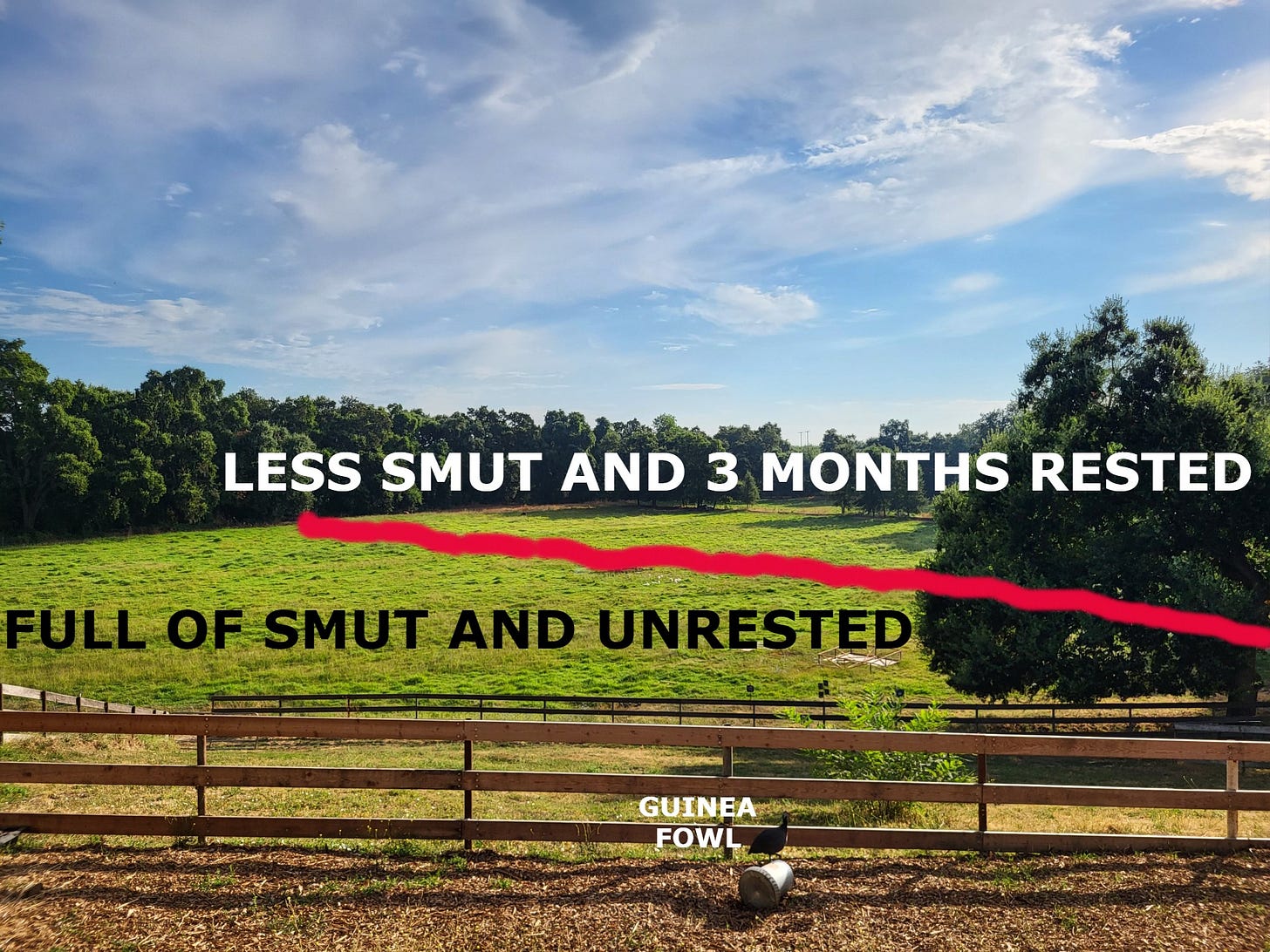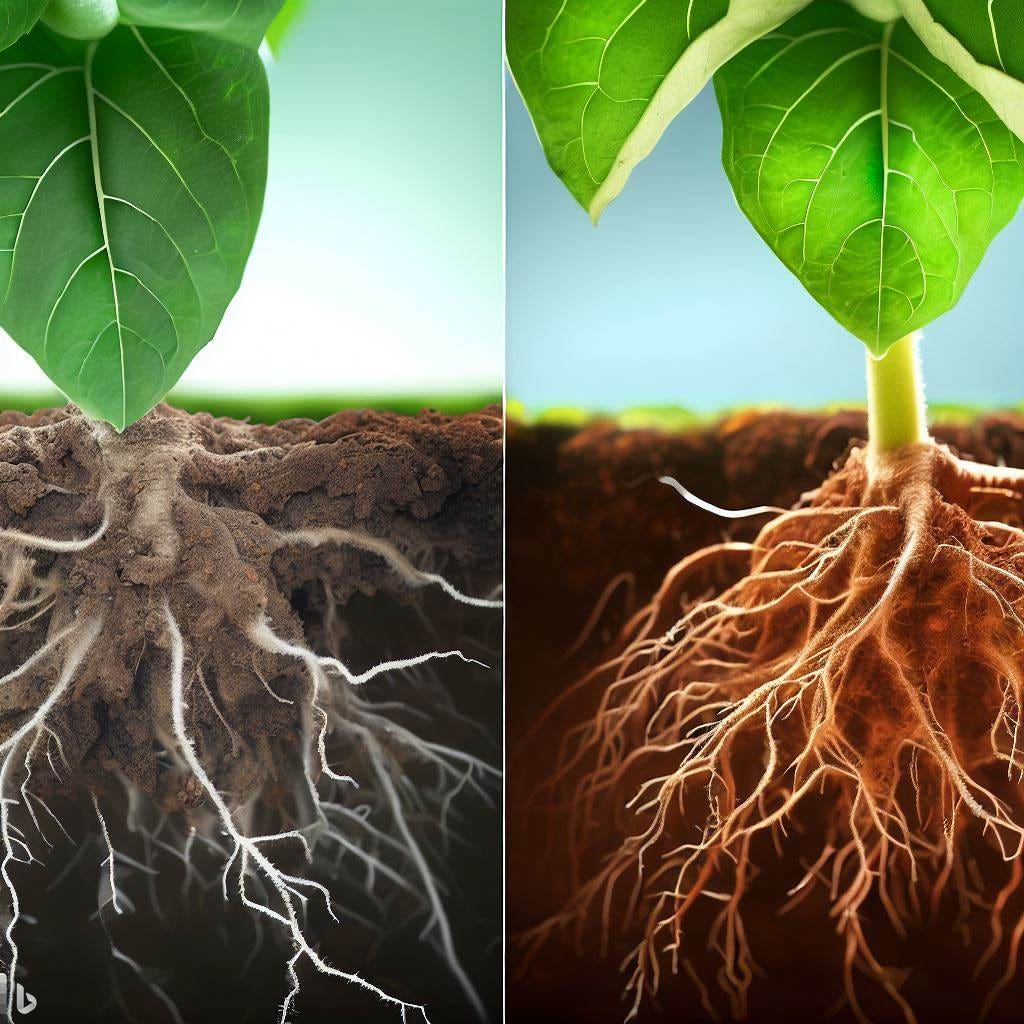Grass, also called the "Earth's Peach Fuzz," is likely going to be my most challenging struggle this year, especially when that grass is measured in acres, named Smutgrass, and has descriptors like "low foliage content," "damaging to livestock nose and eyes," and lastly, my favorite, "prolific in irrigated pastures." What a wonderful trifecta of character traits to address for the next several years!
The silver lining in tackling the above-mentioned stabby-eye grass is that last year, my father-in-law was kind enough to relinquish pasture duties and irrigation responsibilities to my wife and me. We installed a barbed wire fence line, cutting off three acres of pasture (shown in red below), and limited the cows' access to it, which allowed the grass last year a couple of months at the height of summer to grow up, but more importantly than the upward growth was the downward development happening in the form of deep roots. If the most desirable grass is being eaten and all of its energy is going to leaf production and not root development, it will inevitably die off and leave room for something to grow that the cows don't like and won't eat... looking at you Smutgrass!
I have been rotating the cattle on the three acres for six weeks, and where they grazed on week one already looks better than any of the other four acres not allowed a rest period last year, and it is due to the fact that one has roots to rely on, the other does not. I did not cure the three acres of weeds by any means; it has its own undesirables, but it is definitely on its way to being healthier than it has been in decades.
Were the pasture to be tackled quickly and in a 21st-century method, I would need to hire a tractor and operator to come in with some form of tilling equipment, I would need to buy chemical fertilizers, herbicides, and fungicides, I would need to buy equipment to drill the seeds into the soil, and probably a smaller tractor to assist with that, then sprayers and ancillary equipment. All I want to do is help my land heal itself through guidance, not force. Nothing sounds less appealing to me than doing it the modern way, albeit the faster and easier way.
Nature has provided all the equipment I need to get my pasture up and operating as a mostly self-sustained ecosystem. The reason that man decided to do it himself is that he is an impatient and greedy idiot. Everything man has done in agriculture in the past century has been to make things faster, and he has successfully done that, but it has been at the cost of what nature was already doing 100% clean and free, merely at its own pace. Modern understanding of the interconnectedness of the planet's plant, insect, and animal life makes the preference for quick and ugly methods over slow and healthy even more disgusting because it is direct and purposeful harm to an unknowing American population for the sake of profits.
I digrass.
Initial steps have been taken to heal the pasture in the form of poultry. These happy little drumsticks get released onto the pasture where they can poo and wee as much as possible, and in the course of them merely existing on pasture they are scratching the soil and fertilizing it, all without me having to do anything other than feed, water, and move them. I am not certain how effective it has been to date because of the small amount of space that the birds are taking up in comparison to the size of pasture that needs fertilization and because this is year one of truly working the pasture, but I have no doubt that the method works.
I have decided the best focused attack option to be aerating the pasture with a setup from Black Boar, which I will use with my ATV. I spent no less than three hours researching different aerators, and it was either several thousand for a professional setup or $250 for bolted-together metal the thickness of a nickel that looked like it would have a hard time puncturing Jello. I don't remember what magical Google search mantra I entered, but I immediately liked the design of the tines and the fact that the ATV and rider are the weights on the Black Boar equipment vs cinder blocks as shown on the cheaply made options I saw.
I will also be using my DR Power tiller to tackle the larger patches of Smutgrass and Bermuda that are prolific in many areas of the pasture. Bermuda grass, bless its sweet little rhizome-having heart, likes to grow MORE prolifically with tilling due to getting chopped up into thousands of potential starts. Everything online suggests using chemicals over the course of several years to destroy it... of course. After tilling, I anticipate planting a winter grass consisting of Fescue and an Orchardgrass, and when Spring 2024 rolls around I can aerate and seed for better summer grass, and over the course of several years nature will be able to bring a gorgeous pasture back to a glory likely not seen for a hundred years.





